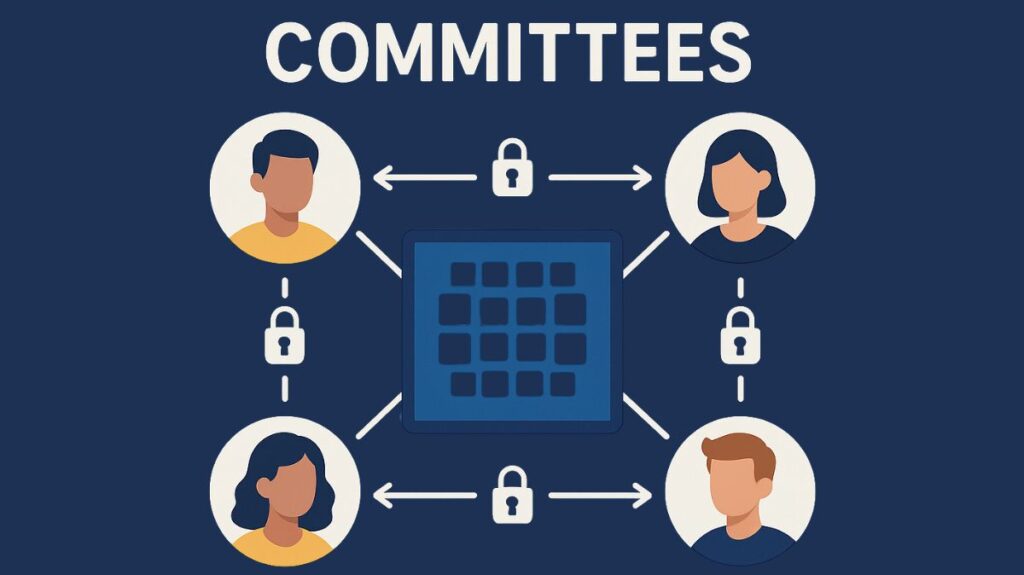Unpack the functions and uses of committees across industries, examining scenarios where they are beneficial and identifying the key disadvantages Of Committees that organizations must navigate for effective operation.
Committees

Committees in the context of blockchain are groups of nodes or participants who have been given specific tasks, mostly to validate transactions and reach consensus on the blockchain’s current state. In blockchain topologies intended for increased scalability or certain trust models, like permissioned or consortium blockchain networks, these committees are very prevalent. They are also a crucial component of the consensus processes used in sharded blockchains. Although their deployment adds complications to their selection and incentive providing, they are essential in enhancing scalability, efficiency, and security inside these networks.
Here’s a more thorough breakdown of blockchain committees:
Purpose of Committees
Within a network, blockchain committees perform a number of vital tasks, including:
- Scalability: By allocating the workload among several groups, committees make it possible to execute transactions in parallel, which speeds up transaction processing and increases throughput. More transactions can be handled concurrently by the system as a whole because to this division of labour.
- Efficiency: Committee-based blockchains can finalize blocks more quickly than networks that depend on huge, global consensus mechanisms since they use smaller groups of nodes for consensus. This improves overall efficiency.
- Security: Committees can increase security by spreading trust among several people, which lowers the possibility of a single point of failure. To fend off hostile actors working within the committee, they can also apply Byzantine fault tolerance (BFT) techniques. Randomization, anonymity, and a dearth of interaction during the selection process can all aid in defending committee members against cyberattacks.
Types of Blockchains
Several consensus methods and blockchain architectures use committees:
Sharded Blockchains: This architecture splits the network into smaller, parallel strands, or shards. The committee that oversees each shard independently manages its own Byzantine consensus method and concurrently handles several sets of transactions. Because this design enables horizontal scaling, as the number of shards increases, so does the overall transaction processing capability. A crucial point to keep in mind is that controlling a single shard (committee) may be simpler for fewer nodes than controlling the entire network.
Consortium Blockchains: In these blockchains, a pre-selected group of organizations or participants work together to establish a committee that oversees the network. Every consortium member usually keeps up a node and actively engages in the consensus-building process.
Permissioned Blockchains: Like consortium blockchains, permissioned blockchains use committees for a number of tasks, such as governance and transaction validation, and need users to be authorized to participate.
Committee Applications
Consensus Mechanism Specifics:
- A representative committee of randomly selected, anonymous users is used by Algorand for every block. These committee members suggest or verify Byzantine consensus and transmit the committee’s findings. Following voting procedures, a committee is also utilized for certification.
- Randomness is used by Ethereum 2.0 (Beacon Chain) to choose attestation committees and block proposers impartially. The beacon chain randomly selects shard validators into committees to reach consensus on block content, and these validator sets (committees) are essential for voting on proposed blocks. Following each epoch, these committees’ validators are switched around.
- By assigning voting authority to “witnesses,” who are then selected in an election process to confirm blocks, Delegated Proof of Stake (DPoS) creates a kind of committee.
- A predetermined group of reliable nodes that serve as validators and propose and validate new blocks might be a part of Proof of Authority (PoA), which essentially creates a committee of authorized players.
- The Helix-based consensus mechanism elects nodes to participate based on their reputation and employs arbitrary committees for Practical Byzantine Fault Tolerance (PBFT) instances.
Disadvantages of committees

Despite the many advantages that committees provide, there are also significant issues and concerns that must be taken into account:
- Committee Selection: To pick trustworthy nodes and represent the network accurately, a fair and effective committee selection process is needed. DPoS and PoS are often used to choose committee members.
- Incentives: Committee members must be urged to act ethically and reach consensus. Crafting reward systems that encourage participation and discourage undesirable behaviour is crucial.
- Communication Overhead: Committee members must communicate well to establish consensus swiftly. Complexities may arise with large committees or latency-heavy networks.
- Security Risks: Committees can improve security, but if the selection process is not done correctly or if bad actors are able to get inside the committee, they can also create new attack points.
Examples of Blockchain Projects Using Committees
A number of noteworthy blockchain initiatives make use of committee-based methodologies:
- Tendermint: Committees are employed to obtain consensus in this well-known BFT consensus engine, which is utilised by numerous blockchains, including Cosmos.
- Polygon Avail: A committee-based method is used by the data availability layer to store and validate data from other blockchains.
- Celestia: Another modular blockchain that uses committees to make data available so that other blockchains can store their data on the network of Celestia.
Other Contexts for “Committees”
Other blockchain-related scenarios can also use the term “committees”:
- Decentralized Autonomous Organizations (DAOs): As a kind of governing committee, investors or token holders frequently organize into a collective that votes on issues like how money is allocated.
- Enterprise Settings: A group of executives may be tasked with overseeing several cryptographic keys in real-world business situations, so acting as a security committee.
- Payment Channels: Though they are usually short-lived and tiny, their usefulness can be expanded to accommodate more participants, necessitating multi-signature cooperation that may resemble a “channel network” or other temporary committee.
In conclusion, especially in sharded and permissioned networks, committee-based consensus methods are an effective way to increase the scalability and effectiveness of blockchains. However, to guarantee that these processes work as intended, substantial thought must be given to committee selection, incentives, and security.
